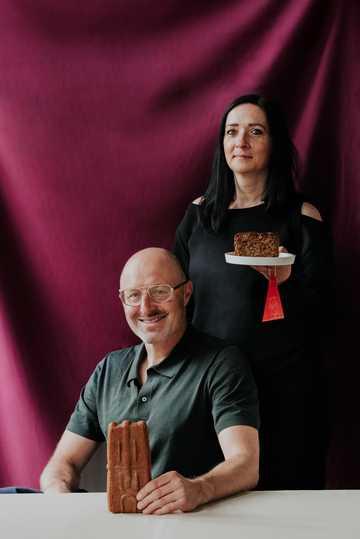
Broodbroeders & Awardt
Gift a fragrant gingerbread from Broodbroeders
Broodbroeders has been making artisanal breads with Mechelen sourdough for ten years. Their regular customers are also happy to wait in line a little longer for the croissants and chocolate cakes. Exclusively for Mmm ... Mechelen, they have made a gingerbread with Renaissance roots: using rye, apple and pear syrup and a secret spice mixture. And a special edition to give to someone.
|
Thanks to Margaret of Austria, Mechelen became the hotspot for everything hip and happening at the beginning of the 16th century. 12 Mechelen tastemakers have used the new and classic ingredients of that time to create the delicacies of today. |

Gingerbread spices from the Renaissance
Steven Van der Stichelen: ‘To make a classic gingerbread, you need flour, honey and spices. For the spice mixture, we only use spices that were already in use in the Renaissance. Fennel seeds from this region, and cinnamon, ginger and cloves that entered our country via the port of Antwerp. You won't find honey in our gingerbread, but delicious apple and pear syrup. It wouldn't have been their number one choice in the Middle Ages, but it's all the more justifiable today when the bees are struggling.’
St Rumbold's biscuit
They also ate gingerbread at the Court of Savoy of Margaret of Austria. Except that gingerbread didn't look like the one you know today. The spiced honey cake was harder, festively decorated and often came in beautiful shapes. The cake was given as a gift, to be put in the room as a fragrant ornament, only to be eaten later. That's why Broodbroeders have made two versions for you: a sweet, softer cake and a real hard biscuit in the shape of St Rumbold's Tower.
‘In the time of Margaret of Austria, recipes and cookbooks did exist, but they were for the richest citizens, and for special occasions. To know what ordinary people ate, we have to take a look underground. In waste pits and cesspools, for example of inns, we find the remains of grains, vegetables, herbs, fruit, meat and fish. If we combine that information with seasons and kitchen techniques from that time, we get a good idea of what was on people's plates then. At court and also in the homes of ordinary folk.’
Jeroen Van Vaerenbergh, The Food Archaeologist
A nod to Mechelen’s gold leather
Steven Van der Stichelen: ‘We really wanted to turn the hard biscuit into a work of art, ideal as a gift. Fully in line with the network of late medieval craftsmen in the city, we are working together with Awardt for this purpose. Els has made the leather labels which you can use as a keychain when the biscuit has been eaten. A nod to Mechelen as the centre of gold leather production at that time.’
Artisanal sourdough bakery
Steven Van der Stichelen: ‘Broodbroeders stands for quality over quantity. We still knead by hand. And to make our bread rise, we don’t use industrial yeast, but a natural product: sourdough. Because the slower the dough rises, the more the flavours interact and the fuller and tastier your bread is. Now you can find sourdough bakeries everywhere, but 10 years ago we were among the pioneers.’
‘The love for our product is reflected in everything we do. For example, we work with a miller from Sint-Joris-Weert who prefers to grind slowly rather than produce a lot. We take the loaves to our pick-up points by bike. And we are the only bakery that works with bread subscriptions, to limit surpluses. Every new product we develop fits into that philosophy.’
St Rumbold’s Tower
Steven Van der Stichelen: ‘I like to travel, but I also like to come back. And the first landmark is St. Rumbold’s Tower. When I see the tower, I know I’m home. Even when I cycle around the city, it’s a point of reference.’
|
About Mmm... Mechelen Mmm... Mechelen is a culinary route through the city, past 10 Mechelen tastemakers who will give you a taste of the cuisine of the Burgundian, golden 16th century. Discover the nine other delicacies at www.visitmechelen.be/en/mmm-mechelen. |